Abstract
This paper studies the possibility of minimizing energy consumption during 35/50 bitumen storage. Similarly to most bitumen companies, the company with which we collaborated uses fossil fuel to maintain bitumen tanks at 150 °C. The main objective is to optimize energy usage. To achieve this purpose, we tested two new storage processes. One is based on dynamic temperature storage between 140 and 160 °C, and the other on room temperature conditions. This work evaluates the effect of these storage conditions on the quality of 35/50 bitumen, and studies the energy aspect to calculate the energy profit for every storage method. After storage, we have studied short-term and long-term ageing using the Rolling Thin Film Oven (RTFOT) and the Pressure Ageing Vessel (PAV) tests, respectively. We characterized the samples using needle penetration at 25 °C, the softening point, and Attenuated Total Reflectance-Fourier Transform Infrared (ATR-FTIR) spectroscopy. We observed that the change in physical properties is negligible after the tested storage processes. Chemically, both the storage conditions affected the oxidative behavior acceptably; the carbonyl index was the same in the long term. We conclude that we can store 35/50 bitumen at room temperature conditions, which follow us to save more than three times the energy needs compared to the standard configurations.
1. Introduction
The bitumen storage process is highly energy-consuming because pure bitumens are supposed to be maintained at high temperatures that go from 130–150 °C for the softest, PG (Penetration Grade) 160/220, to 175–190 °C for the hardest, PG 10/20 [1]. The purpose is to keep the viscosity of bitumen at a level that allows us to pump it smoothly. In addition, to avoid the risk of damaging its properties by exposing it to a temperature that is lower or higher than its normal range.
Bitumens are subjected to phenomena of ageing. These lead to changes in their mechanical and rheological parameters and their chemical structure. Ageing makes the bituminous coatings lose their flexibility, causes an increase in the rigidity of asphalt, leading to the degradation of asphalt. This phenomenon is essentially due to two mechanisms. The first mechanism is irreversible, characterized by a chemical change in the binder, which thus affects its rheological properties. The processes causing it are oxidation produced by reactions with atmospheric oxygen [2], the loss of the oily components present in bitumen by volatility due to high temperature [3], and the absorption of oily components by porous aggregates [4]. The degree of oxidation is highly dependent on the temperature, the time, and the thickness of the bitumen film. Penetration-grade bitumens are relatively involatile; thus, the amount of hardening resulting from the loss of volatiles is usually insignificant [5]. The second mechanism is steric or physical hardening [6]. It is a reversible process, which occurs when the bitumen is at ambient or low temperatures. It is usually attributed to the reorientation of bitumen molecules and the slow crystallization of waxes [7,8].
There are two types of ageing; one occurs during the bitumen storage and mixing (short-term ageing), and the other in service (long-term ageing). The circumstances under which ageing happens vary considerably. During storage, the bitumen is in bulk at a high temperature for days or weeks. During mixing, transport, and application, the bitumen is a thin film at a high temperature for a relatively short period. In service, the bitumen is a thin film at a low or moderate temperature for a very long time. The more compact the asphalt, the less hardening of bitumen occurs, because the void presence increases the degree of exposure to the air [8].
Many laboratory ageing methods had been created to simulate what happens during short-term (TFOT, RTFOT, RFT) and long-term (RCAT, PAV, UV, VBA) ageing [9,10,11]. The thin film oven test (TFOT) consists of ageing 3.2 mm thick binder films in an oven for 5 h at 163 °C. Bitumen films in TFOT are not agitated nor rotated; therefore, there is a concern about limiting the ageing on the sample’s surface. This is when RTFOT (rolling thin film oven test) was created, which can be considered an enhanced form of TFOT. In RTFOT, 1.25 mm thick rotating films in glass bottles are aged at 163 °C, for 75 min [9,10]. The rotating flask test (RFT) consists of ageing a 100 g sample of bitumen in the flask of a rotary evaporator for 150 min at 165 °C. Hot air is blown into the flask at a rate of 500 mL/min during ageing. The flask is rotated at a speed of 20 rpm [10]. The rotating cylinder ageing test (RCAT) is used to simulate bitumen’s long-term ageing; 500 g of the binder is introduced into a cylinder which is subsequently rotated at 1 rpm. This rotation ensures a distribution of the binder into an even 2 mm thick film. Oxygen is introduced into the cylinder at a rate of 75 mL/min. The ageing process takes 144 h at 85 °C [10]. The pressure-ageing vessel (PAV) test consists of ageing 3.2 mm thick bitumen films at 100 °C for 20 h under an air pressure of 2.07 MPa. In these conditions, the PAV test should be preceded by the RTFOT test, although it was found that if the PAV test is conducted for 25 h, the result is equivalent to 75 min RTFOT + 20 h of PAV [9,10]. Ultraviolet (UV) ageing has been simulated in different ways that make comparing the results difficult. Although most studies agree on using a 500 W lamp for various short-term ageing simulations, there are differences in terms of the intensities employed, the thickness of the film of bitumen, and the conditioning of the samples. There are also variations in the intensity of radiation employed that can range between 450 and 1200 µW/cm2. As in the case of the PAV test, bitumen samples undergo RTFOT before exposing them to UV ageing [9]. The Viennese binder ageing (VBA) method is the newest ageing simulation method; it was created in 2020 by Mirwald et al. [11]. The VBA considers the presence of reactive oxygen species (ROS) found in the atmosphere and near the pavement surface; it incorporates two ROS (O3 and NOX) into its ageing atmosphere.
The entire world is working towards moderating energy consumption in industries, with the main purpose of economic gain. Fortunately, with this pure economic vision comes a noticeable decrease in the emissions from combustion systems; hence, a benefit on the environmental level. In the last decade, there has been a broad trend in industries towards renewable energies. The bitumen industry is not an exception to that; many studies have been realized to evaluate using solar energy and wind energy in bitumen heating systems. Regrettably, solid oxide fuel cells (SOFCs) are still an unexplored area in the bitumen industry. These are a clean, efficient, and low-cost source of energy [12]. Fuel cells convert the chemical energy of a fuel gas directly into electrical energy and heat [13]. Hopefully, we will soon be able to see studies on the use of SOFCs in the heating process of bitumen. In 2008, Luminosu et al. [14] studied solar energy usage in passive mode to preheat D80/100-type bitumen up to 55 °C per day and achieved an increment in this temperature to 63 °C. In 2018, Anoune et al. [15] sized a PV–wind-based hybrid system that could be used to supply electrical load demands, to maintain a constant storage temperature of bitumen by compensating the thermal losses of bitumen tank through an immersed electrical heater. In 2020, Ghazouani et al. [16] worked on the optimization of thermal energy management of a solar thermal energy system for bitumen maintaining on process heat. It is a promising substitute to fossil energy, but unfortunately, the whole system costs more than a fuel heater. This is why new methods to optimize energy consumption during bitumen storage while using fossil energy are needed. In 2018, Shah et al. [17] worked on the optimization of 60/70 paving grade bitumen’s mixing temperature using polyurethane foam (PUF) and plastic waste (PW) as modifiers. They found that the use of 40 wt.% PUF resulted in a decrease in mixing temperature from 170 °C to 135 °C, which enabled a fuel saving of up to 33%. However, the use of more than 10 wt.% PW compromised the binder’s characteristics.
Hence, the purpose of this work is to study the feasibility of two different bitumen storage methods that do not require fossil energy replacement nor binder modification. Moreover, the aim was to determine the best method amongst them based on a combination of the energetic profit and the impact on bitumen’s properties and quality. The first storage method is based on creating multiple downtimes throughout the storage period. To do so, we used thermal fluctuations to create a dynamic regime of heating. Instead of maintaining bitumen temperature at 150 °C through its storage period, we increased the temperature to 160 °C and then stopped the energy supply, and let the temperature decrease to attain 140 °C. We repeated this operation during the entire storage period, creating a sort of thermal cycle. Thermal cycling has been studied before, focusing on thermal fluctuations that occur naturally during the “in-service” part of bitumen’s lifetime. Merbouh studied the effect of thermal cycling on the creep–recovery behavior of road 40/50 paving grade bitumen, where they used heating/cooling (25 °C/45 °C; 45 °C/65 °C) and freezing/thawing (−15 °C/20 °C) cycles (90 cycles each) to simulate climate changes in different regions and during different seasons. They found that these two phenomena have both affected bitumen properties in different ways. The first one decreased bitumen susceptibility and caused the hardening of the material, which reduces rutting but increases the risk of thermal cracking at low temperatures. The second one increased both bitumen susceptibility and the risk of rutting at high temperatures [18]. Glaoui et al. studied the impact of thermal fatigue cycles on the rheological behavior of polymer-modified bitumen. They applied 100 cycles (representing 100 days) of freezing/thawing between −10 °C and 25 °C and found that these cycles make the modified binder softer and more deformable, cause an increase in the susceptibility and the risk of rutting, and produce a loss of consistency [19].
The second storage method that we studied is room temperature storage at 25 °C for the storage period. Tarsi et al. studied PG 70/100, PG 40/60, and polymer-modified bitumen ageing at room temperature (24.6 °C) for 5, 10, 15, 20, and 25 days, focusing on the chemical and rheological changes [20].
Thus, this paper’s novelty consists of optimizing energy consumption in the bitumen industry without adding any modifiers to our 35/50 bitumen while using fossil energy. It contains four sections, organized in this manner: the first section provides an accurate depiction of the studied problem; the second section provides a detailed description of the materials and methods used for the study and offers data and specifications; the third section discusses the obtained results and provides recommendations; finally, conclusions are summarized in the fourth section.
2. Materials and Methods
This research is part of a project that deals only with 35/50 paving grade bitumen; the impact of different storage conditions on other classes/types of bitumen might be studied in the future. To study the effect of temperature fluctuations and ambient temperature on 35/50 bitumen during storage, we used a 35/50 penetration-grade bitumen from one source. Bituma Company, a partner in the project, provided us with the samples needed. Two samples served as a reference (control samples), which were stored at 150 °C in a 40-ton tank in Bituma Company and had not undergone any further thermal treatment; the other two were thermally cycled between two different temperatures (140 and 160 °C), whereas the last ones were stored at room temperature (25 °C) for 90 days. Throughout the article, the control sample is referred to as “BP”, the thermally cycled sample is “BP + TC”, and the room-temperature-stored sample is “BP + RT”.
We applied laboratory tests (penetration at 25 °C, softening point, and FTIR-ATR) on all the samples, two samples per category, and then calculated the average value for each thermal treatment.
We wanted the results of the study to be reliable; therefore, we needed it to cover the whole lifetime of the binder, which is why we evaluated the impact of these storage methods on bitumen properties using short-term and long-term ageing simulation. After each ageing stage (unaged, short-term ageing, long-term ageing), we applied characterization tests to assess the change in the samples’ physical and chemical properties. The methodology followed is summarized in Figure 1.
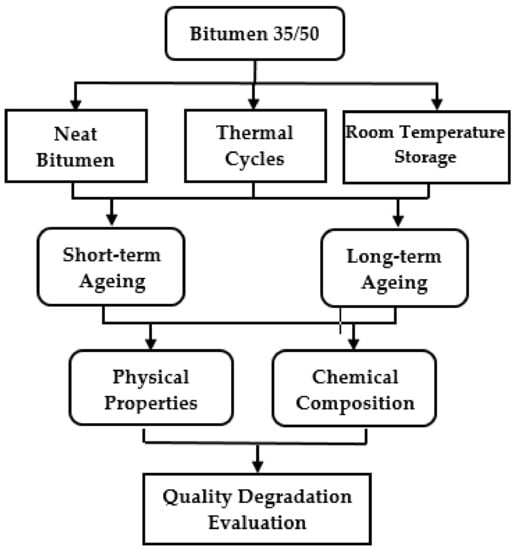
Figure 1.
Scheme of the work methodology.
2.1. Bitumen Thermal Storage Analysis
2.1.1. Problem Formulation
The thermal storage was conducted in a temperature shock test chamber Votsch 7012S3. Room-temperature storage was conducted at 25 °C for 90 days. Thermal fluctuations were carried out between 140 °C and 160 °C with cycle numbers equal to 100. The cycles’ number is representative of three months of storage in a 40-ton bitumen tank. We chose 90 days because it is considered the maximum bitumen-storing period by Bituma Company. We chose this temperature range so that we could economize energy with a ΔT = 20 °C, and at the same time, stay around 35/50 bitumen storage temperature in Bituma Company (=150 °C). The neat bitumen that we used as a reference was stored at 150 °C in a Bituma Company 40-ton tank.
2.1.2. Thermal Loss Calculation
The heat losses from the bitumen storage tank (Figure 2) to the ambient were evaluated based on heat transfer calculations. In this case, the heat transfer rate was strongly related to the isolation quality, tank configuration, ambient temperature, wind speed, and the temperature difference between the tank and air or ground [16]. Therefore, the tank surface area was divided in four parts as shown in Figure 3: the dry sidewall, the wet sidewall, the tank bottom and the tank roof.
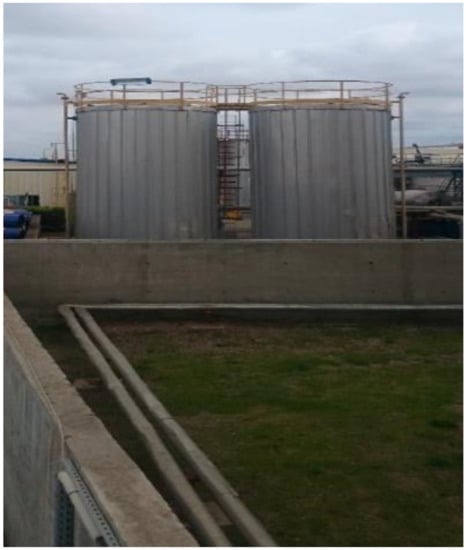
Figure 2.
Bitumen reservoir studied in the factory.
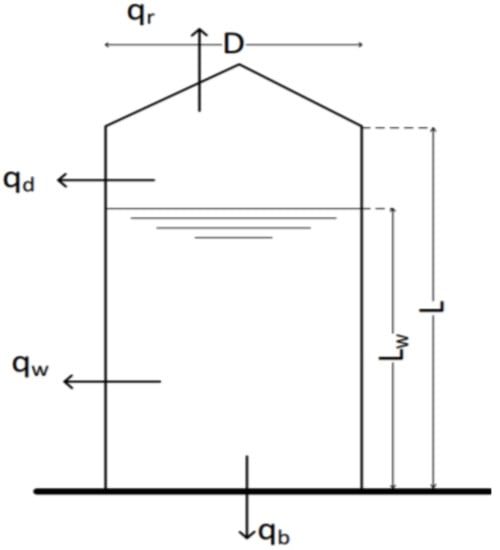
Figure 3.
Typical vertical–cylindrical tank.
- ✓ For dry sidewall
- ✓ For wet sidewall
- ✓ For tank-bottom
- ✓ For tank roof
Finally, the total heat loss is given by:
where U, A, and T refer to the overall heat transfer coefficient, the transfer area, and the temperature, respectively. The subscripts d, w, b, r, v, a, and L refer to dry, wet, bottom, roof, vapor, ambient, and liquid, respectively. The overall heat-transfer coefficient for the dry sidewall of the tank (U) was calculated as the sum of the resistances of vapor film, fouling, metal wall, insulation (if any), and outside air (convection plus radiation). The overall heat transfer coefficient for each surface was calculated by the following equation (Equation (6)):
where h, e, and k refer to individual film heat transfer coefficients, thickness, and conductivity, respectively. The subscript i, e, M, and I refer to internal, external, metal, and insulation, respectively.
2.2. Ageing Procedures
We simulated the short-term ageing of bitumen using the rolling thin film oven test (RTFOT) following EN 12607-1 [21]. Short-term ageing occurs during storage, mixing, transport, and placing [8]; hence, the RTFOT test was conducted at 163 °C for 75 min, with a rotation frequency of 15 rpm and a hot air flow equal to 4000. After the RTFOT, we applied all the characterization tests.
The long-term ageing was simulated using the pressure-ageing vessel (PAV), as per EN 14769 [22]. Long-term ageing occurs during the in-service phase of the binder’s lifetime [8]. The PAV test was conducted at 100 °C, under a pressure of 2.1 MPa for 20 h. These conditions represent 5 to 7 years of in-service ageing. Before realizing the PAV test, we performed RTFOTs on the concerned samples. After PAV, we evaluated the change by applying our predefined tests.
2.3. Physical Properties Testing
We needed to evaluate bitumen’s properties at the three ageing stages tested: Unaged, RTFOT-aged, and RTFOT + PAV-aged. To assess the change in the binder’s consistency and viscoelastic consistency, we used the penetration at 25 °C and the determination of softening point R&B tests, respectively.
The objective of the penetration test is the determination of bitumen consistency at 25 °C. We realized this test as per the procedure described in EN 1426 [23]. A standardized steel needle penetrates vertically into a bitumen sample at 25 °C. The needle load is 100 g, and the loading time is equal to 5 s. The penetration unit is [0.1 mm], which corresponds to the needle penetration depth in the bitumen sample.
The softening point R&B test specifies bitumen properties at high service temperature. Its result represents a conventional, approximate upper limit of the viscoelastic consistency. We realized this test following the procedure described in EN 1427 [24]. Two metal rings are filled with bitumen, then heated in a controlled manner in distilled water, placed in a glass beaker, with each bitumen-filled ring supporting a steel ball. The softening point is the average temperature at which both bitumen rings soften to the point that each ball covered in bitumen travels a distance of 25.0 mm ± 0.4 mm. We express the result of the softening point test in [°C].
2.4. Chemical Composition: ATR-FTIR
We used attenuated total reflectance Fourier-transform infrared (ATR-FTIR) spectroscopy to identify the functional groups in bitumen that appear or increase with ageing. It is well known that the formation of carbonyl and sulfoxide chemical functional groups indicate the bitumen oxidation level [7,25,26]. The oxidation can be identified by a pronounced increase in absorption in the carbonyl and sulfoxide regions in the FTIR spectrum.
In this study, bitumen oxidative ageing was characterized using UATR-FTIR measurements at 23 °C, in a Perkin Elmer Two Fourier Transformed Infrared Spectrometer in the Attenuated Total Reflectance mode with a diamond crystal. The collected spectra were acquired with 8 repetitive scans and ranged from 400 to 4000 cm−1 with a 4 cm−1 resolution. With a spatula, we took a slight amount of non-melted bitumen and pressed it against the crystal of the ATR accessory, and then we started the scan. In less than one minute, we had obtained a high-quality spectrum for our bituminous material. The crystal of the spectrometer was cleaned using acetone.
Table 1 shows the functional groups we usually observe in a pure bitumen FTIR spectrum, and the bond vibrations and wavenumbers associated with them. The focus will be on the oxidative products, which are carbonyl and sulfoxide groups. The carbonyl group is known to peak at around 1700 cm−1, and the sulfoxide group at around 1030 cm−1.

Table 1.
Absorption wavenumbers of functional groups in bitumen.
3. Results and Discussion
3.1. Physical Properties Evaluation
The penetration and softening point tests results, after each thermal treatment and at every ageing stage, are presented in Table 2. The residual penetration and the increment of softening point were calculated after the RTFOT using Equations (7) and (8), respectively [18]:
Residual Penetration (%) = Pafter/Pbefore,
Increment of Softening point (°C) = SPafter − SPbefore.

Table 2.
Penetration and softening point tests results.
The penetration value of 35/50 paving grade bitumen should be between 35 and 50 [0.1 mm], and its softening point between 50 and 58 °C. After short-term ageing, residual penetration should be ≥ 53%, and the increment of softening point should be ≤ 8 °C. We can observe from the results in Table 2 and the histograms in Figure 4; Figure 5 that our bitumen kept its conformity to 35/50 bitumen standards after being stored at room temperature (25 °C) and thermally cycled between 140 and 160 °C, at both post-storage and short-term ageing stages. We can consider the difference negligible, which means that both thermal storage methods did not affect the binder’s physical properties. After the long-term ageing stage, penetration results were the same, the softening point showed a higher increase after room temperature storage, but it is still a slight difference of 1.2 °C. From the increment of softening point values and residual penetration values, it is clear that BP + TC has aged the most after short-term ageing.
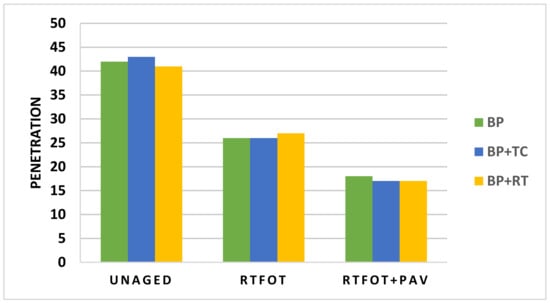
Figure 4.
Penetration test results of all the samples at different ageing stages.
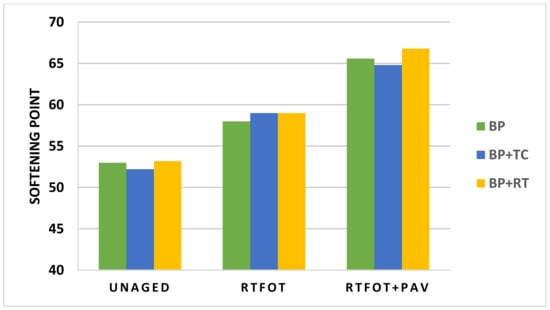
Figure 5.
Softening point test results of all the samples at different ageing stages.
3.2. Ageing Index
To compare the ageing progression, we calculated the ageing index by dividing the penetration and softening point values at RTFOT-aged and RTFOT + PAV-aged stages by their values at the unaged stage (Equation (9)) [27]. For penetration at 25 °C, the higher the ageing index, the less the bitumen hardens (less ageing), whereas for the softening point R&B, the higher the ageing index, the more the bitumen hardened (more ageing).
Ageing Index = Aged value/Unaged value
Figure 6 and Figure 7 show the ageing index for penetration at 25 °C and softening point R&B, respectively. We can see from Figure 6 that, after RTFOT and RTFOT + PAV the penetration of BP reached 0.62 and 0.43 times that of the unaged binder, respectively; the penetration of BP + TC reached 0.6 and 0.4 times that of the unaged binder. Additionally, the penetration of BP + RT reached 0.66 and 0.41 times that of the unaged binder. Figure 7 shows that the softening point of BP attained 1.09 and 1.24 times that of the unaged binder, the softening point of BP + TC reached 1.13 and 1.24 times that of the unaged binder, and the softening point of BP + RT reached 1.11 and 1.25 times that of the unaged binder, after RTFOT and RTFOT + PAV, respectively.
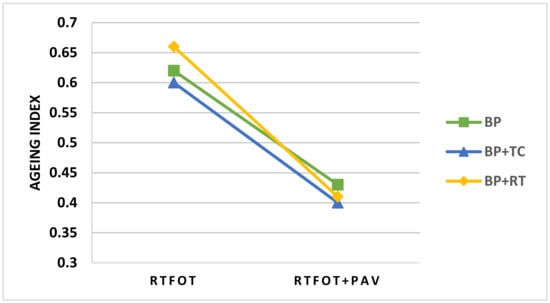
Figure 6.
Ageing index for penetration at 25 °C.
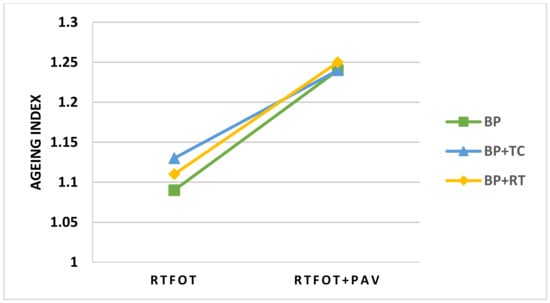
Figure 7.
Ageing index for the softening point R&B.
We can see from the figures that BP + TC aged more than the other two samples after short-term ageing. After long-term ageing, the softening point ageing index showed the same ageing degree for all three samples. The penetration ageing index shows that the BP + TC aged more than the other samples confirming the short-term ageing results. The differences between the penetration ageing index values and the softening point ageing index values are insignificant at the long-term ageing stage. This means that at the end of the bitumen lifetime, we will have the same ageing degree whether we maintain it at 150 °C during its storage, store it at ambient temperature for 90 days, or fluctuate it between 140 and 160 °C for three months.
3.3. Penetration Index and Temperature Susceptibility
The penetration index is a quantitative measure of the response of bitumen to a given temperature. It represents the temperature susceptibility of bitumen, which is how fast the binder changes its consistency as temperature changes. The lower the penetration index, the faster the binder changes its consistency as the temperature changes (which shows greater temperature susceptibility). This index, conceived by Pfeiffer and Van Doormal [28], is calculated from the penetration and softening point values (Equation (10)). It provides a criterion for measuring the susceptibility of bituminous materials to temperature changes. It also helps in predicting their rheological behavior. Most of the bitumens used in road construction have penetration index values between −1 and +1. In this range, bitumens have intermediate characteristics between elasticity and viscous behavior [29].
The value of the temperature susceptibility varied from 0.0015 and 0.06, and we calculated it using Equation (11). Pfeiffer and Van Doormal developed this equation assuming a temperature susceptibility value of about zero for road bitumen [30].
We calculated the penetration index for our three samples according to Equation (10), and the results are shown in Table 3. Then, we calculated the temperature susceptibility using Equation (11) and represented the results in Figure 8. We can see from Table 2 that the PI values of BP and BP + RT are the same, whereas it decreased a little for BP + TC. Observing Figure 8, the temperature susceptibility values of BP and BP + RT are the same (0.045), whereas that of BP + TC (0.046) has increased by 0.001, which we can consider negligible. Thus, these results confirm the previous results, showing that the control sample and the room-temperature-stored sample are the same, which means that bitumen storage at 25 °C for 90 days does not affect its physical properties. Although the thermally cycled sample exhibits a small change, we can store bitumen in a dynamic temperature-heating regime, between 140 and 160 °C, for three months or less. The difference in physical properties was imperceptible for three months of storage and will be more negligible or nonexistent if the storage duration is shorter.

Table 3.
Penetration index values.
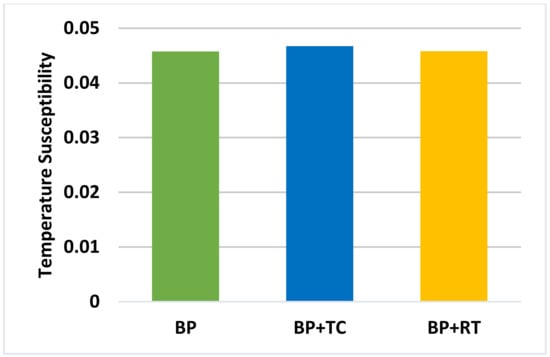
Figure 8.
Temperature susceptibility of our three samples.
3.4. ATR-FTIR Analysis
We collected the spectra between 4000 and 400 cm−1, but we have presented only the part that contains the peaks of interest. To have a clearer presentation of the peaks, we used OriginPro software to perform baseline correction. Figure 9, Figure 10 and Figure 11 show the absorption spectra (after baseline correction) for BP, BP + TC, and BP + RT, respectively, at different ageing stages (Unaged, RTFOT-aged, RTFOT + PAV-aged).
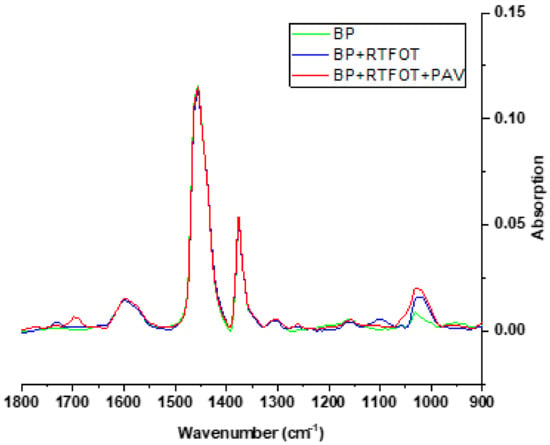
Figure 9.
FTIR spectra for BP at all ageing stages.
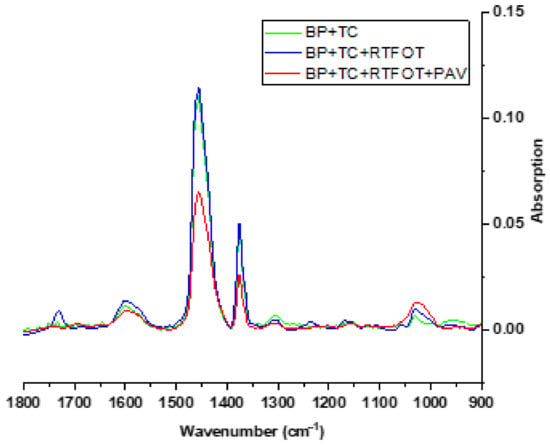
Figure 10.
FTIR spectra for BP + TC at all ageing stages.
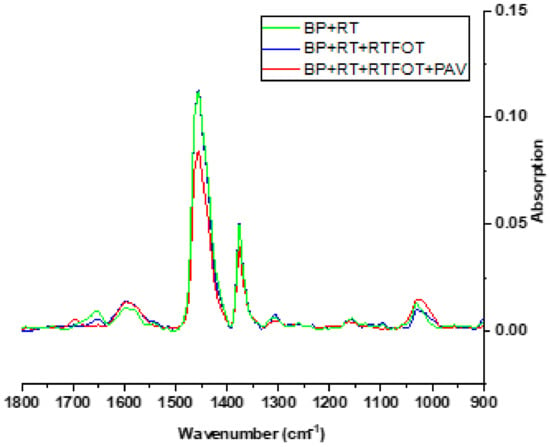
Figure 11.
FTIR spectra for BP + RT at all ageing stages.
We observe from Figure 9 that the BP at its unaged state shows no carbonyl peak, whereas the Sulfoxide peak at 1036 cm−1 is present. After short-term ageing, the sulfoxide peak is wider, which indicates an increase in sulfoxide group formation, and we can see a weak, broad carbonyl peak at 1739 cm−1 (aldehydes). After long-term ageing, we can see that the sulfoxide peak is larger, and we observe the appearance of a broad peak of carbonyl at 1700 cm−1 (ketones). Both the sulfoxide group and the carbonyl group changed significantly after ageing; thus, they can reflect the ageing degree of bitumen to a certain extent. The appearance of the absorption peak of the carbonyl group (C=O) is probably due to the oxidation reaction of carbon and corresponds to the long-term ageing.
From Figure 10, it is clear that BP + TC has the same behavior as BP. At the unaged state, it shows no carbonyl peak and a sharp sulfoxide peak at 1032 cm−1. After short-term ageing, a carbonyl peak appears at 1730 cm−1 (aldehydes), and the sulfoxide peak becomes larger. After long-term ageing, we observe a broad carbonyl peak at 1700 cm−1 (ketones), and the sulfoxide peak is even larger. In the case of the BP + TC + RTFOT + PAV sample, the changes in the carbonyl functional group at 1700 cm−1 and the sulfoxide functional group at 1030 cm−1 reflect the change in the aromatic ring components, which are the main components in BP. These changes can reflect the oxidation degree of BP during the pressure-ageing vessel test (PAV), which resulted in broad sulfoxide and carbonyl peaks. These results are in good agreement with those cited in the literature, as Yao et al. have cited in their work on the FTIR spectroscopy characterization of asphalt binders’ ageing-related properties, during the ageing of the asphalt, the resins and asphaltenes react with oxygen and produce more aromatic hydrocarbons and polar functional groups. This can be an explanation as to why ketones in the asphalt increase after PAV ageing [31].
Figure 11 shows that the BP + RT sample exhibited no carbonyl peak, although it presented a visually larger sulfoxide peak (1030 cm−1) at its unaged state, compared to BP and BP + TC. After short-term ageing, a weak carbonyl peak appeared at 1740 cm−1 (aldehydes), and the sulfoxide peak increased slightly. After long-term ageing, such as in the BP + TC FTIR spectra, a broad carbonyl peak appeared at 1700 cm−1 (ketones).
In order to obtain a clearer idea of the samples’ chemical composition evolution with ageing, we performed an FTIR semi-quantitative study according to the French MLPC Method No. 69 for binders “Identification et dosage des fonctions oxygénées présentes dans les liants bitumineux—analyse par spectrométrie infrarouge à transformée de Fourier” [32]. This method calculates the carbonyl index (ICO) and the sulfoxide index (ISO) based on the peak areas of the FTIR spectrum as given in Equations (12) and (13), respectively; thus, an accurate idea of the change in oxidation level could be derived by comparing those indices.
where ACO is the area centered around 1700 cm−1, ASO is the area centered around 1030 cm−1, and Ar is the area centered around 1460 cm−1 plus the area centered around 1375 cm−1.
ICO = ACO/Ar
ISO = ASO/Ar
We integrated the peaks using OriginPro software. Figure 12a,b present a comparison, at every ageing stage, of the neat bitumen’s carbonyl index (curve) and sulfoxide index (grouped histogram) values with those of the thermally cycled sample (BP + TC) and the sample stored at room temperature (BP + RT), respectively.
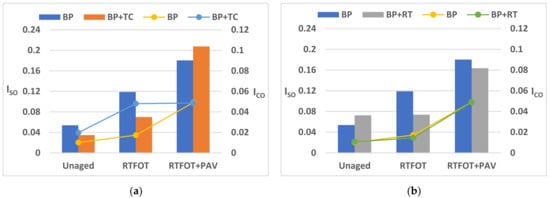
Figure 12.
Carbonyl index (curve) and sulfoxide index (grouped histogram) values at every ageing stage of (a) BP and BP + TC; (b) BP and BP + RT.
Figure 12a shows that, at the unaged stage, BP + TC exhibited higher carbonyl index (0.019) and a lower sulfoxide index (0.034) values compared to BP (ICO = 0.010 and ISO = 0.053), which means that the thermal fluctuation storage favored carbonyl formation at the expense of sulfoxide. After short-term ageing, the carbonyl index of BP + TC is much higher (0.047) than that of BP (0.014), whereas the value of its sulfoxide index doubled from 0.034 to 0.069, which is much lower than BP’s ISO (0.118).
We can see from the unaged stage results in Figure 12b that room temperature storage did not affect the carbonyl amount because BP and BP + RT had the same ICO (0.010), although it led to an increase in sulfoxide formation (from 0.053 to 0.072). After short-term ageing, the ICO results confirm those of the unaged stage; the carbonyl index values of BP and BP + RT are very close (0.014 and 0.017). BP + RT kept its initial ISO (0.073) after short-term ageing, whereas the value of ISO for BP doubled from 0.053 to 0.118.
After long-term ageing, the ICO is the same for all the studied storage conditions (0.0490 for BP, 0.048 for BP + TC, 0.048 for BP + RT), whereas ISO is at its highest level for BP + TC (0.206) and its lowest for BP + RT (0.166).
Table 4 shows the evolution of carbonyl and sulfoxide indices from one ageing stage to another. We calculated, for every sample, the differences between the indices’ values at the unaged stage and their values after RTFOT, as well as the difference between the indices’ values after RTFOT and their values after PAV. The objective was to compare the oxidative behavior in every ageing condition.

Table 4.
Oxidation evolution with ageing stages.
We can see from the results that, as with carbonyl, BP and BP + RT are similar; they aged slightly in the short term, then aged more in the long term. BP + TC is the opposite; it aged in the short term and did not age in the long term.
Concerning sulfoxide, the three samples exhibited different behaviors. BP performed a 50/50 oxidation; it aged similarly in both the short and long term. BP + RT did not age in the short term and aged in the long term. However, BP + TC aged in the short term, then aged considerably more in the long term.
We conclude that at the end of bitumen’s lifespan, the oxidative ageing effect on carbonyl is the same regardless of the storage conditions. Room temperature storage minimized sulfoxide formation; therefore, it is a better choice for 35/50 bitumen.
3.5. Thermal Heat Loss Scenarios
After calculating the heat loss using Equations (1)–(5), we calculated the energy demand for each storage scenario. Figure 13 shows the energy required and the cost for a bitumen tank for the storage period (90 days) for different scenarios. The first scenario is storing bitumen at ambient temperature (25 °C) and heating it at the end of the period to 160 °C. The second scenario is maintaining the temperature of bitumen in the range of 140 °C and 160 °C. The third scenario is the Bituma Company scenario, which consists of maintaining the bitumen temperature at 150 °C.
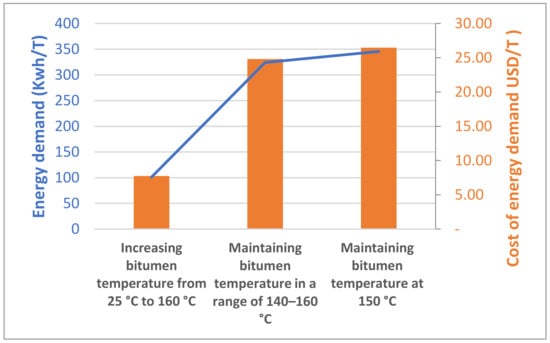
Figure 13.
Different storage scenarios: Increasing bitumen temperature from 25 °C to 160 °C, maintaining bitumen temperature in a range of 140 °C and 160 °C, and maintaining bitumen temperature at 150 °C.
The results show that in order to store bitumen at 25 °C for 90 days and then heat it to 160 °C, the energy demand is equal to 101 kwh/T. However, storing bitumen in a dynamic heating process, fluctuating between 140 and 160 °C, requires 324 kwh/T. The Bituma Company scenario (maintaining T° at 150 °C) requires 345 kwh/T, which means that we save 244 kwh/T and 21 kwh/T if we use scenarios one and two, respectively.
Considering that the fuel price is 0.05 USD/kWh [16], we conclude that by using the second scenario, we economize 6% (1.58 USD/T), whereas we save 71% (18.8 USD/T) when we use the first scenario compared to the third scenario in the storage period.
4. Conclusions
This work has studied the possibility of adopting two different bitumen storage methods to minimize energy consumption. We compared thermally static bitumen storage at 150 °C to dynamic temperature storage based on fluctuations between 140 and 160 °C, and room temperature storage at 25 °C. The main findings can be summarized as follows.
- On the physical aspect, a minor change was observed after each thermal storage method compared to the control sample. Bitumen kept its conformity to 35/50 bitumen standards at every ageing stage, and the ageing degree was the same for the three specimens after long-term ageing;
- On the chemical aspect, both the storage processes studied affected bitumen oxidative behavior differently. In the long term, ambient temperature storage minimized the sulfoxide group formation, whereas dynamic temperature storage caused an increase in the latter. This impact is acceptable and will be less if we store bitumen for a period less than the maximum storage period that we studied (90 days);
- On the energetic aspect, the calculations showed that the thermal fluctuation storage saved 6% and the ambient temperature storage saved 71% compared to the energy consumption in Bituma Company storage tanks;
- On the economic aspect, these energy savings applied to a storage period of 90 days translate into an economy of 18.8 USD/T and 1.58 USD/T when we store at room temperature and using thermal fluctuations, respectively.
From these findings, we conclude that we can recommend both the storage methods studied in this work, with a preference for minimizing the storage period. For saving more energy, ambient temperature storage is the best choice, but it is preferable to apply it to smaller tanks to heat bitumen smoothly and rapidly when it needs to be pumped. Bitumen can be pumped immediately if its temperature is between 140 °C and 160 °C; hence, it is advisable to use dynamic temperature storage for large tanks.
Author Contributions
Conceptualization, A.T. and M.B.; methodology, A.T. and M.B.; validation, A.T.; formal analysis, A.T.; investigation, A.T.; data curation, A.T. and M.G.; writing—original draft preparation, A.T. and M.G.; writing—review and editing, M.B., O.A. and T.C.; visualization, A.T. and M.G.; supervision, M.B., O.A. and T.C.; project administration, M.B.; funding acquisition, M.B. All authors have read and agreed to the published version of the manuscript.
Funding
This research was funded by IRESEN, grant number INNOPROJET-2014, ‘‘Maintain the bitumen storage heat by using the solar thermal collector’’.
Institutional Review Board Statement
Not applicable.
Informed Consent Statement
Not applicable.
Data Availability Statement
The data presented in this study are available upon request from the corresponding author.
Acknowledgments
The authors would like to thank Achraf Chakir and Loubna Najemi for all the advice. We thank Khalid El Azdi, director at CERIT/LPEE, for allowing us to perform the ageing tests at the entity’s laboratory; Nora Mbirkat, technician at CERIT/LPEE, for her tremendous help with the tests. We would like to thank Ilham Bouzida, QA engineer at MAScIR, for thermal storage services and for her patience, and Rachid Bouhfid, senior researcher at MAScIR, for ATR-FTIR spectroscopy services. The authors want to thank also “Bituma SA” for the collaboration and the information shared to complete this study.
Conflicts of Interest
The authors declare no conflict of interest. The funders had no role in the design of the study; in the collection, analyses, or interpretation of data; in the writing of the manuscript, or in the decision to publish the results.
References
- Lombardi, B.; Kazziha, S. Bitume.Info: Aménager, Construire, Innover; Special Issue-1; Groupement Professionnel des Bitumes (GPB): Paris, France, 2005; p. 33. [Google Scholar]
- Petersen, J.C.; Branthaver, J.F.; Robertson, R.E.; Harnsberger, P.M.; Duvall, J.J.; Ensley, E.K. Effects of physicochemical factors on asphalt oxidation kinetics. Transport. Res. Rec. 1993, 1391, 1–10. [Google Scholar]
- Lu, X.; Issacson, U. Laboratory study on the low temperature physical hardening of conventional and polymer modified bitumen. Constr. Build. Mater. 2000, 14, 79–88. [Google Scholar] [CrossRef]
- Curtis, C.W.; Ensley, K.; Epps, J. Fundamental Properties of Asphalt-Aggregate Interactions Including Adhesion and Absorption, SHRP-A-341; National Research Council: Washington, DC, USA, 1993. [Google Scholar]
- Afechkhar, M. Vieillissement des Bitumes et Effet sur les Performances des Enrobés Bitumineux. Centre National des Etudes et Recherche, Direction des Routes et de la Circulation Routière. In Proceedings of the 7ème Congrés National de la Route, Ouarzazate, Morocco, 9–10 November 2007; Available online: www.ampcr.ma/actes/7eme_congres_national_de_la_route/CONGRE/TH4/TH4_17.pdf (accessed on 13 September 2021).
- Freeston, J.L.; Gillespie, G.; Hesp, S.A.M.; Paliukaite, M.; Taylor, R. Physical Hardening in Asphalt. In Proceedings of the Canadian Technical Asphalt Association 60th Annual Conference, Ottawa, ON, Canada, 15–18 November 2015; Volume LX, pp. 54–81. [Google Scholar]
- Petersen, J.C. Chemical composition of asphalt as related to asphalt durability: State of the art. In Asphaltenes and Asphalts, 2. Development in Petroleum Science; Yen, T.F., Chilingarian, G.V., Eds.; Elsevier: Amsterdam, The Netherlands, 1984; Volume 40, Part B, pp. 363–399. [Google Scholar]
- Read, J.; Whiteoak, D. The Shell Bitumen Handbook, 5th ed.; Thomas Telford Publishing: London, UK, 2003. [Google Scholar]
- Tauste, R.; Moreno-Navarro, F.; Sol-Sánchez, M.; Rubio-Gámez, M.C. Understanding the bitumen ageing phenomenon: A review. Constr. Build. Mater. 2018, 192, 593–609. [Google Scholar] [CrossRef]
- Wu, J. The Influence of Mineral Aggregates and Binder Volumetrics on Bitumen Ageing. Ph.D. Thesis, The University of Nottingham, Nottingham, UK, May 2009. [Google Scholar]
- Mirwald, J.; Maschauer, D.; Hofko, B.; Grothe, H. Impact of reactive oxygen species on bitumen aging—The Viennese binder aging method. Constr. Build. Mater. 2020, 257, 119–495. [Google Scholar] [CrossRef]
- Corigliano, O.; Fragiacomo, P. Extensive analysis of SOFC fed by direct syngas at different anodic compositions by using two numerical approaches. Energy Convers. Manag. 2020, 209, 112664. [Google Scholar] [CrossRef]
- Corigliano, O.; Florio, G.; Fragiacomo, P. A performance analysis of an anaerobic digester—High temperature fuel cells fed by urban solid waste biogas. Energy Source Part A 2011, 34, 207–218. [Google Scholar] [CrossRef]
- Luminosu, I.; Fara, L. Experimental research on bitumen preheating (fluidization) by using solar energy in passive mode. Int. J. Therm. Sci. 2009, 48, 209–217. [Google Scholar] [CrossRef]
- Anoune, K.; Laknizi, A.; Bouya, M.; Astito, A.; Ben Abdellah, A. Sizing a PV-Wind hybrid system using deterministic approach. Energy Convers. Manag. 2018, 169, 137–148. [Google Scholar] [CrossRef]
- Ghazouani, M.; Bouya, M.; Benaissa, M.; Anoune, K.; Ghazi, M. Thermal energy management optimization of solar thermal energy system based on small parabolic trough collectors for bitumen maintaining on heat process. Solar Energy 2020, 211, 1403–1421. [Google Scholar] [CrossRef]
- Shah, S.A.R.; Arshad, H.; Waqar, A.; Saeed, M.H.; Hafeez, S.; Mansoor, J.; Sadiq, A.N.; Malik, M.A. Saving energy in the transportation sector: An analysis of modified bitumen application based on Marshall test. Energies 2018, 11, 3025. [Google Scholar] [CrossRef] [Green Version]
- Merbouh, M. Effect of thermal cycling on the creep-recovery behavior of road bitumen. Energy Procedia 2012, 18, 1106–1114. [Google Scholar] [CrossRef] [Green Version]
- Glaoui, B.; Merbouh, M.; Ven, M.; Chialleux, E.; Youcefi, A. How thermal fatigue cycles change the rheological behavior of polymer-modified bitumen. Proceedings of TerraGreen 13 International Conference 2013—Advancements in renewable energy and clean environment. Energy Procedia 2013, 36, 844–851. [Google Scholar] [CrossRef] [Green Version]
- Tarsi, G.; Varveri, A.; Lantieri, C.; Scarpas, A.; Sangiorgi, C. Effects of different aging methods on chemical and rheological properties of bitumen. J. Mater. Civ. Eng. 2018, 30. [Google Scholar] [CrossRef] [Green Version]
- European Committee for Standardization. EN 12607-1:2014. Bitumen and Bituminous Binders—Determination of the Resistance to Hardening under the Influence of Heat and Air. 2014. Available online: https://standards.iteh.ai/catalog/standards/cen/5e1f0c0a-99bc-4c99-a191-cf07c1482527/en-12607-1-2014 (accessed on 13 September 2021).
- European Committee for Standardization. EN 14769:2013. Bitumen and Bituminous Binders—Accelerated Long-Term Ageing Simulated by a Pressure Ageing Vessel (PAV), AFNOR, France. 2013. Available online: https://infostore.saiglobal.com/en-au/standards/nf-en-14769-2013-36667_saig_afnor_afnor_82014/ (accessed on 13 September 2021).
- European Committee for Standardization. EN 1426:2015. Bitumen and Bituminous Binders—Determination of Needle Penetration. 2015. Available online: https://standards.iteh.ai/catalog/standards/cen/853455a7-1455-4f3e-a2b8-60d17bfdf3df/en-1426-2015 (accessed on 13 September 2021).
- European Committee for Standardization. EN 1427:2015. Bitumen and Bituminous Binders—Determination of the Softening Point. Ring and Ball Method. 2015. Available online: https://standards.iteh.ai/catalog/standards/cen/0edd2612-e3e1-43b4-b533-8debe5c55040/en-1427-2015 (accessed on 13 September 2021).
- Petersen, J.C.; Glacer, R. Asphalt oxidation mechanisms and the role of oxidation products on age hardening revisited. Road Mater. Pavement Des. 2011, 12, 795–819. [Google Scholar] [CrossRef]
- Lu, X.; Isacsson, U. Effect of ageing on bitumen chemistry and rheology. Constr. Build. Mater. 2002, 16, 15–22. [Google Scholar] [CrossRef]
- Ongel, A.; Hugener, M. Impact of rejuvenators on ageing properties of bitumen. Constr. Build. Mater. 2015, 94, 467–474. [Google Scholar] [CrossRef]
- Pfeiffer, J.; Van Doormaal, P. The rheological properties of asphaltic bitumens. J. Inst. Pet. 1936, 22, 414–440. [Google Scholar]
- Normativa de Carreteras. NLT-181/99 Indice de Penetracion de los Betunes Asfalticos, Spain. 1999. Available online: https://normativadecarreteras.com/listing/nlt-18199-indice-penetracion-los-betunes-asfalticos/ (accessed on 13 September 2021).
- Olugbenga, A.E.; Olugbenga, A.F.; Jonathan, G. Softening point and penetration index of bitumen from parts of southwestern Nigeria. Nafta Zagreb 2012, 63, 319–323. [Google Scholar]
- Yao, H.; Dai, Q.; You, Z. Fourier Transform Infrared Spectroscopy characterization of aging-related properties of original and nano-modified asphalt binders. Constr. Build. Mater. 2015, 101, 1078–1087. [Google Scholar] [CrossRef]
- Institut Français des Sciences et Techniques des Réseaux, de l’Aménagement et des Transports (IFSTTAR). French MLPC Method, No.69 for Binders: Identification et Dosage des Fonctions Oxygénées Présentes dans les Liants Bitumi-neux—Analyse par Spectrométrie Infrarouge à Transformée de Fourier. 2010. Available online: https://www.ifsttar.fr/fileadmin/user_upload/editions/lcpc/MethodeDEssai/MethodeDEssai-LCPC-ME69.pdf (accessed on 13 September 2021).
Publisher’s Note: MDPI stays neutral with regard to jurisdictional claims in published maps and institutional affiliations. |
© 2021 by the authors. Licensee MDPI, Basel, Switzerland. This article is an open access article distributed under the terms and conditions of the Creative Commons Attribution (CC BY) license (https://creativecommons.org/licenses/by/4.0/).